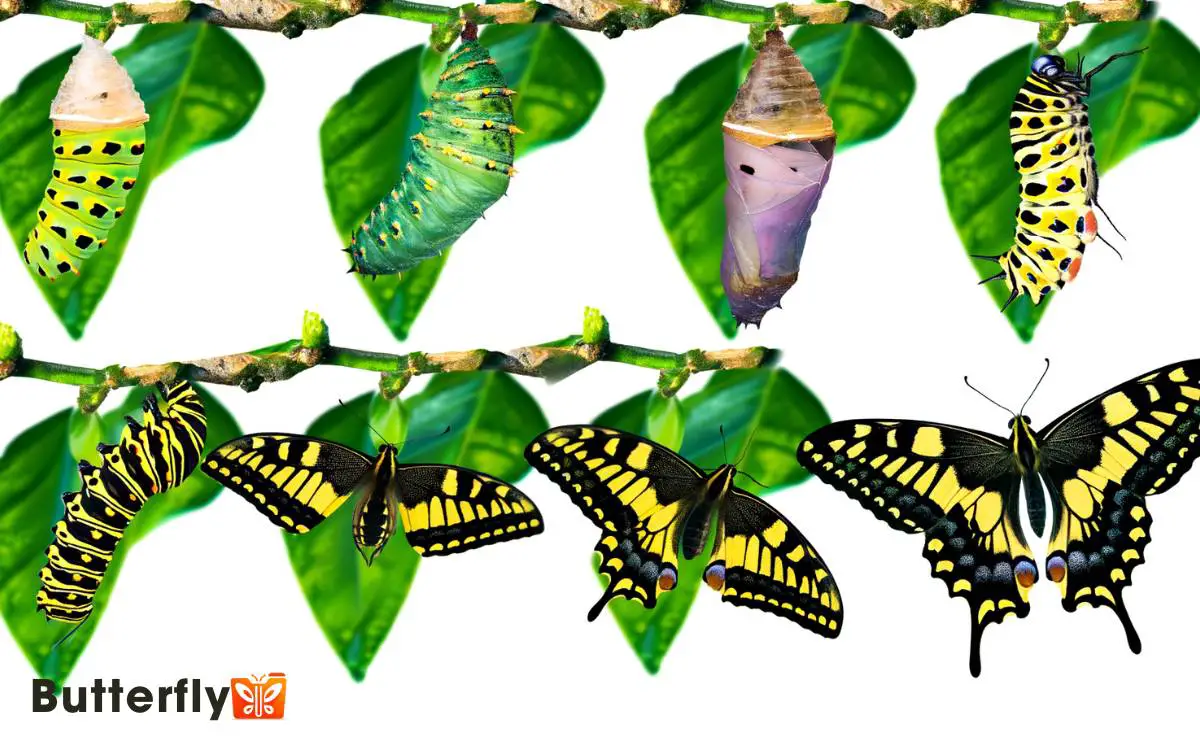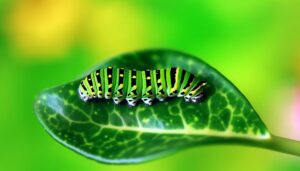Giant Swallowtail Butterfly Life Cycle: A Complete Guide!
The Giant Swallowtail butterfly’s lifecycle consists of several intricate stages. Females lay yellowish eggs on the undersides of host plant leaves.
Larvae hatch, consume their eggshells for nutrients, and feed voraciously on citrus plants. Their distinct coloration offers camouflage. Larvae undergo multiple molts, each termed an instar, and use osmeteria for defense.
They then form a chrysalis during the pupation stage, where significant tissue reorganization occurs.
Finally, adults emerge from the chrysalis, unfurling and drying their wings, ready for their first nectar meal. To understand the fascinating details of each stage, further exploration is essential.

Key Takeaways
Egg Stage
Typically, the female Giant Swallowtail butterfly lays her eggs singly on the leaves of host plants. She selects specific citrus species, driven by the plants’ chemical cues.
The eggs are small, round, and display a yellowish hue. By depositing them individually, the female minimizes competition among larvae and maximizes survival chances.
Each egg’s surface has a finely reticulated texture, facilitating gas exchange. These eggs remain exposed to various environmental elements, yet their placement on the underside of leaves offers a degree of protection from predators.
The strategic selection of host plants guarantees that upon hatching, larvae will have immediate access to food. This meticulous process reveals the butterfly’s adaptive behaviors to optimize offspring viability, showcasing an intricate balance between risk and survival.
Hatching Process
Once the eggs are ready to hatch, the larvae instinctively break free from their finely reticulated shells, beginning their journey as caterpillars.
This emergence is marked by a delicate yet determined effort, as the larvae use specialized mandibles to create a small opening in their eggshells. The process, called eclosion, unfolds rapidly, often occurring within minutes.
Observers note the precision with which the larvae execute this task, ensuring minimal energy expenditure. After breaking free, the larvae consume their eggshells, a practice known as exochorionophagy, providing essential nutrients for their initial growth phase.
This self-reliant act signifies the larvae’s first step towards autonomy, setting the stage for their subsequent developmental stages in the intriguing lifecycle of the Giant Swallowtail butterfly.
Larval Development
Having consumed their eggshells, the newly emerged larvae commence their larval development phase, characterized by rapid growth and frequent molting.
During this period, the larvae, often referred to as caterpillars, exhibit distinctive coloration that mimics bird droppings, serving as an effective camouflage against predators. They voraciously feed on host plants, primarily citrus species, to accumulate necessary nutrients.
As they grow, they undergo a series of molts, each stage termed an instar. In each instar, the caterpillar’s size and coloration change, indicating progression.
Importantly, the larvae possess osmeteria, specialized organs that emit a foul odor when threatened, providing an additional defense mechanism.
This relentless feeding and molting cycle continues until they reach their final instar, fully preparing them for the next phase.
Pupation
As the final instar concludes, the caterpillar seeks a secure location to commence pupation, transforming into a chrysalis. It attaches itself to a twig or leaf using silk, forming a girdle to hold its body in place.
The caterpillar’s skin splits, revealing the chrysalis underneath. This transformation marks a critical phase where the larva’s tissues undergo significant reorganization.
The chrysalis’ cryptic coloration offers camouflage against predators, ensuring its survival during this vulnerable stage.
The pupal phase can last several weeks, depending on environmental conditions. During this time, internal processes break down larval structures and form adult characteristics.
This metamorphosis encapsulates nature’s intricate balance between vulnerability and resilience, reflecting the innate drive for freedom and transformation.
Emerging as an Adult
The mature butterfly breaks free from the chrysalis, unfurling its wings to harden and expand in preparation for flight.
This critical phase, known as eclosion, involves the butterfly pumping hemolymph into its wing veins, causing them to straighten and enlarge.
Initially, the wings appear crumpled and moist, but within hours, they dry and solidify, achieving their full span.
Observing the Giant Swallowtail at this stage reveals intricate patterns and vibrant colors that weren’t visible within the chrysalis. The butterfly’s proboscis, previously coiled, now extends, ready for its first nectar meal.
Every movement is deliberate, as the newly emerged adult strengthens its muscles in anticipation of its imminent freedom. This marks the culmination of metamorphosis, transforming from a grounded creature to one capable of flight.
Adult Butterfly Life
Upon emerging, the adult Giant Swallowtail Butterfly engages in distinct feeding habits, primarily sourcing nectar from a variety of flowering plants.
Observations indicate their preference for certain floral species, which ideally provide necessary nutrients.
Concurrently, their mating behavior becomes a focal activity, with males actively seeking females to guarantee reproduction.
Feeding Habits
Adult Giant Swallowtail butterflies primarily feed on nectar from various flowering plants, displaying a preference for species rich in essential nutrients. Observations indicate that they favor blossoms such as lantana, azalea, and bougainvillea.
Their proboscis, an elongated feeding tube, allows them to extract nectar efficiently. By favoring flowers with high concentrations of carbohydrates, amino acids, and lipids, these butterflies make sure they meet their energetic and reproductive needs.
They exhibit a dynamic foraging strategy, often visiting multiple flowers in succession, which maximizes nutrient intake. This feeding behavior not only sustains their metabolism but also aids in the pollination of the plants they visit, fostering a mutualistic relationship.
Mating Behavior
While their feeding habits help sustain their energy, Giant Swallowtail butterflies also engage in intricate mating behaviors essential for reproduction.
Males patrol territories, seeking receptive females. They utilize chemical cues, specifically pheromones, to locate potential mates. This behavior guarantees genetic diversity and successful propagation of the species.
The following table outlines key aspects of their mating behavior:
| Behavior | Description | Purpose |
|---|---|---|
| Territory Patrol | Males patrol areas to find females | Locate mates |
| Pheromone Release | Males emit chemical signals | Attract females |
| Courtship Display | Visual and tactile interactions | Mate selection |
| Copulation | Physical mating process | Fertilization |
| Post-mating Care | Females lay fertilized eggs on host plants | Ensure offspring survival |
These behaviors highlight the complex and purposeful nature of Giant Swallowtail butterfly reproduction. Females carefully select host plants to lay their eggs, ensuring that the emerging caterpillars have an adequate food source. This selective process contributes to the survival of the species and is one of the fascinating giant swallowtail butterfly facts. Additionally, the caterpillars exhibit unique camouflage, resembling bird droppings to deter predators.
Conclusion
To conclude, the giant swallowtail butterfly’s life cycle is a fascinating journey from egg to adult. Remarkably, only about 2% of eggs survive to adulthood, highlighting the precarious nature of their existence.
Observing these stages – egg, larva, pupa, and adult – reveals the intricate processes and environmental challenges faced.
This low survival rate underscores the importance of conservation efforts to safeguard their habitats and guarantee the continuation of this enthralling species.






